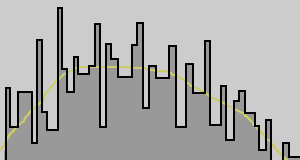The serious reader will be curious as to whether there is any technical usability to this little schematic of the mind I have come up with; i.e., are "Huw Diagrams" something that can be created for a patient and then used to help diagnose and/or benefit them? The short answer is... maybe. Here is one more detail of a section of an imaginary diagram:
Each section represents, in theory, just one mental process and how much conscious thought is available in the subject "between" the absorption of sensation and the encountering of unconscious material. It's height will vary by the amount of unconscious "data" stored beneath it - this is why the sensation line also varies up and down, by the way. Two things are required in order for this tool to be of any technical use (beyond a metaphor or analogy for individual purposes of self understanding). One is a way to determine the actual relative levels of each of these horizontal lines. The other, perhaps more important, is to figure out how the various traits or areas measured should be lined up on the horizontal axis of the diagram. Since the little details can be approximated over wider areas at times, it is their interrelationship that matters more - and knowing what is "next" to what is vital, if the averaging is to be of any validity. The first thing to remember is that this "horizontal axis" will probably have more than one dimension. It is almost certain that it will at least wrap around on itself - that the long sheet of paper required to draw it will have its ends connected, forming a cylinder of sorts. It may also have other places where the meaning of the way the mind works will lead us to connect other places along the way, which would lead it to "look" more like a series of such cylinders, overlapping and intersecting at various points. If it were possible to construct a model along these lines, the various horizontal segments would be labelled with increasing detail depending on the scale of observation. One "side loop" might represent the patients relationship to their mother, and be connected to several other segments at certain points, for instance their relationship with their father, their siblings, and certain sexual issues. The trick is to develop an abstract model of how the broad areas of the mind which all healthy brains exhibit are interelated. An individual patient will have their own quirks and loops due to their own experience, growth, and traumas, but these should always "fit in" to the broader model for it to be useful. Then areas where the patient appears to be fairly secure can be roughly approximated with an "average" curve or line, and the technician can focus their attention on relatively unrelated areas where the subject exhibits difficulties. It would require a great deal of dedication to research this model. The researcher would want to accumulate data that was somehow measured in such a way as to be translatable into the diagram, while perhaps still being useful to others for other reasons. It would require that the researcher keep the model's possibilities and theory in the forefront of their work for many years, even though it may prove to not be viable in the end. That is why it is best if their data is not too specific, that it could be used in other ways as well if this model proves to be more metaphorical than scientific. What form would this process of research and verification take? I think in order to be fairly rigorous, a very detailed questionnaire would have to be developed, partly to be filled in directly by the subject and partly by the researcher. It would attempt to find as many "points" on the diagram as possible by exploring their thoughts, emotions, and reactions. The "art" and serious contribution of the researcher would be to figure out what issues or aspects of the mind should be "next to" each other on the diagram. This would require many, many subjects, so that their particular situations could be abstracted out leaving the common interelations of the mind laid out in a clear schematic. Having analyzed perhaps thousands of subjects of all ages and backgrounds and cultures, the researcher would then have a theoretical framework for the diagram, which would then need to be used to predict things about new subjects. As these predictions succeed or fail, so goes the model. It should work well on basically healthy subjects, and perhaps more importantly, on those who exhibit symptoms of mental illness, or psychosis. It might need to be discarded as a superficial "self help" tool, or perhaps refined to take into account its errors. Perhaps there might turn out to be general associations between "parts" of the mind (not physical parts necessarily, but subjective parts, the way the mind is organized and tends to organize itself) that would be useful to clinicians in the future. Perhaps they would be too broad to be of much use. Only research and time will tell. The time will surely lapse on its own, but will the research take place? 1/1/02 © Huw Powell
|
